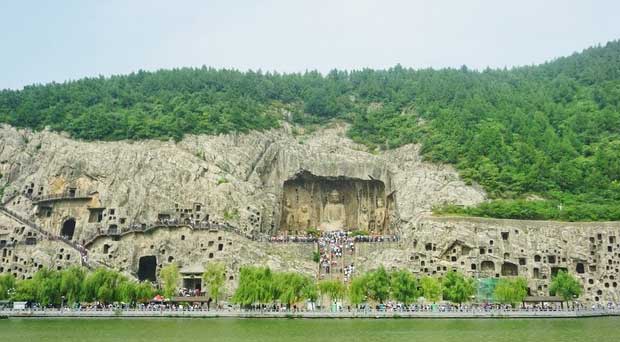
Longmen Grottoes is located at the foot of Longmen Mountain, which is 25 Li south of Luoyang City, Henan Province. There are two opposite sides here. Countless springs flow slowly. The clear Yi River passes through it. Looking far away, it looks like a natural gate tower, so later generations call it Longmen. Because of its beautiful scenery, Longmen has always been a place of interest since ancient times, attracting numerous tourists every year. Bai Juyi, a great poet of Tang Dynasty, once wrote about the four suburbs of Luodu. Maybe because of his nostalgia for Longmen Mountains and rivers, he was buried in Pipa peak of Longmen Mountain after his death. However, it is the stone carving art here that adds luster to Longmen Mountains and waters. Longmen Grottoes are densely distributed on the cliffs on both sides of Yishui river. They are about two li long from north to south. They stand at the same time with the famous Mogao Grottoes in Dunhuang and Yungang Grottoes in Datong, and are called the three art treasures in China.
Longmen Grottoes were founded around the time when Emperor Xiaowen of the Northern Wei Dynasty moved his capital to Luoyang (494 AD). After the Eastern Wei, the Western Wei, the Northern Qi, the Northern Zhou, the Sui and the Tang Dynasties, it has been built on a large scale for 400 years. Since then, there have been chisels in the Five Dynasties and the Northern Song Dynasty. There are more than ten pagodas, over 750 niches, over 1352 caves, over 3600 inscriptions and over 100000 statues on the mountain. The smallest Buddha is only two centimeters high, while the big one is more than ten meters high. Chinese people have regarded calligraphy as an art since ancient times. The famous twenty products of Longmen are beautiful and renowned at home and abroad. They are the cream of Longmen Wei Bei.
Longmen statues are magnificent, numerous and colorful. During the heyday of the Northern Wei Dynasty, Binyang grottoes were built. Among them, Binyang Grottoes is the most magnificent one carved by Longmen rock mountain. There are eleven Big Buddha statues in the cave. The main statue is Sakyamuni Buddha. It is more than eight meters high, with a slightly long face wheel, beautiful eyes and eyebrows, a little smile on the corners of the mouth, a balanced body, gorgeous clothes and decorations. It gives people beautiful artistic enjoyment. It is a representative work of stone Buddha statues in the Northern Wei Dynasty. At the same time, lotus cave, Guyang cave and other grottoes were built.
Tang Dynasty inherited the excellent tradition of the Northern Wei Dynasty and absorbed the world-famous statue of Buddha Da Lu she, the head of Fengxian Temple. It is as high as 17 meters, and the carving is extremely exquisite. The head of the Buddha statue is four meters high, the ears are nearly two meters high, the bun is wavy, the face is plump, the mouth and nose are correct, the ears are naturally drooping, the eyebrows are like the curved moon, the eyes are slightly downward staring, the corners of the mouth are slightly joyful, which seems to give people a sense of charity and peace, warmth and amiability. It is worthy of being a masterpiece of ancient Chinese stone carving works and the crystallization of the wisdom of ancient working people. On both sides of the statue are Arhats, Bodhisattvas, kings of heaven, and powerful men. They are respectively pious, joyful, powerful and ferocious. They are lifelike and very touching. The more than 15000 small Buddhas carved on the two walls of the famous Wanfo grottoes and the beautiful flying sky on the top of the grottoes show the outstanding artistic talents of the sculptors.
In a word, Longmen Grottoes show the infinite wisdom and vigorous creativity of the Chinese nation, which has been cherished by people for a long time.